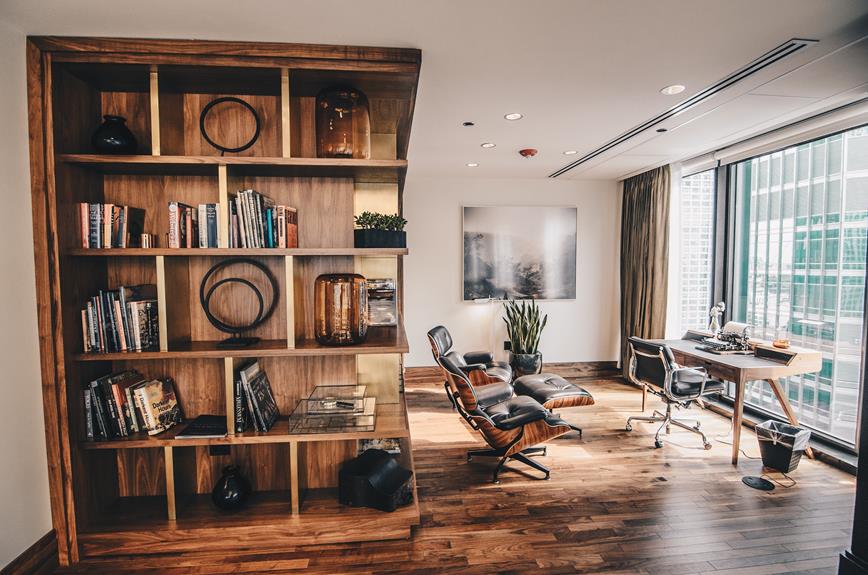Are you tired of feeling chained to your traditional desk? Maybe it's time to think outside the box and explore the world of floor desks.
With their ergonomic design and space-saving functionality, a floor desk could be the game-changer you've been searching for in your home office.
From improved posture to a customized setup that suits your work style, this unconventional option offers a range of benefits to help you master your workspace.
So, if you're ready to break free from the constraints of a regular desk and elevate your home office experience, it's time to consider if a floor desk is the perfect solution for you.
Key Takeaways
- A floor desk promotes good posture and encourages movement, improving circulation and overall health.
- It creates a minimalist and clutter-free workspace, offering ergonomic design and space-saving functionality.
- Desk height and posture should be considered for ergonomic comfort, with the desk adjusted to align with elbows at a 90-degree angle.
- A floor desk takes up minimal floor space, making it ideal for small home offices or multifunctional rooms, and enhances organization and efficiency in the workspace.
Benefits of a Floor Desk
With a floor desk, you can work comfortably and efficiently while sitting or kneeling on the floor. The benefits of using a floor desk in your home office setup are numerous.
First and foremost, it promotes good posture. By allowing you to change positions throughout the day, a floor desk reduces the strain on your back and neck, which is often associated with traditional desk setups.
Additionally, a floor desk encourages movement, as you can easily switch between sitting, kneeling, and even standing, which can help improve circulation and prevent stiffness.
Furthermore, a floor desk promotes a minimalist and clutter-free workspace. Without the need for a bulky desk and chair, you have more freedom to design your home office in a way that suits your aesthetic preferences. This can lead to a more calming and focused work environment.
Moreover, a floor desk is often more affordable than traditional desk setups, making it an attractive option for those looking to create a functional yet budget-friendly home office.
Ergonomics and Comfort
When using a floor desk, it's important to consider your desk height and posture to ensure ergonomic comfort.
Additionally, explore supportive seating options to maintain proper alignment and reduce strain on your body.
Prioritizing ergonomics and comfort can enhance your overall productivity and well-being while working from a floor desk.
Desk Height and Posture
To maintain proper posture and ensure ergonomic comfort while using a floor desk, adjust the desk height to align with your elbows when your arms are at a 90-degree angle. This will help prevent strain on your wrists and shoulders.
When setting up your floor desk, consider the following:
- Sitting Position: Sit cross-legged or with your legs extended, ensuring your hips are higher than your knees for better posture.
- Desk Height: Position the floor desk so that your elbows form a 90-degree angle when resting on it, allowing for comfortable typing and writing.
- Monitor Placement: Place your computer monitor or laptop on a stand or stack of books at eye level to reduce neck strain.
Supportive Seating Options
For optimal ergonomic support and comfort while using a floor desk, you can enhance your setup with supportive seating options that promote better posture and reduce strain on your body.
Consider using meditation cushions and back support to create a comfortable Japanese style sitting position. Meditation cushions provide a firm yet comfortable base, promoting proper alignment and reducing pressure on your lower body.
Back support, such as a cushion or small pillow, can help maintain a natural curve in your spine, preventing slouching and back discomfort.
When choosing supportive seating options, prioritize ones that allow you to sit with your hips slightly higher than your knees, promoting a neutral spine.
Space-Saving Design
Looking to maximize your home office space? Consider a floor desk for its efficient and compact design. Space-saving solutions and home organization are essential in creating an effective workspace, especially when embracing minimalist decor and small space living.
A floor desk offers a sleek and streamlined solution to optimize your home office area. Here's how it can enhance your space:
- Compact Footprint: A floor desk takes up minimal floor space, making it ideal for small home offices or multifunctional rooms.
- Versatile Functionality: Its versatile design allows for easy integration into various room layouts, offering flexibility and adaptability.
- Clutter-Free Workspace: With built-in storage options and cable management features, a floor desk promotes a clutter-free environment, enhancing both productivity and aesthetics.
Incorporating a floor desk into your home office can significantly contribute to a well-organized and efficient workspace, making it a practical choice for those seeking to maximize their available space without compromising on style or functionality.
Productivity and Focus
If you find it difficult to maintain focus and productivity throughout the workday, a floor desk could be the solution for you.
The ergonomic design of a floor desk allows for a comfortable and natural posture, which can positively impact your ability to stay focused and productive.
Additionally, the option to alternate between sitting and standing at a floor desk can help enhance your mind-body connection, further boosting your overall work performance.
Floor Desk Ergonomics
Have you ever tried working on a floor desk, but found yourself struggling to maintain productivity and focus due to the lack of ergonomic support? Achieving the right floor desk posture and incorporating ergonomic accessories can significantly improve your productivity and focus.
Consider the following to optimize your floor desk ergonomics:
- Posture: Maintain proper posture to reduce strain on your body and improve focus.
- Ergonomic Accessories: Invest in accessories such as a floor cushion, adjustable laptop stand, and ergonomic keyboard to support your body and enhance productivity.
- Movement: Incorporate regular breaks and stretching exercises to prevent stiffness and maintain focus throughout the day.
Standing Desk Benefits
Consider the increased productivity and enhanced focus that a standing desk can bring to your home office. Standing desk benefits are well-documented, with studies showing that they can lead to higher energy levels, increased alertness, and improved posture.
By using a standing desk, you can avoid the mid-afternoon slump that often accompanies prolonged sitting, leading to a more consistent level of productivity throughout the day. Additionally, the act of standing can help you feel more engaged and focused on your tasks, contributing to a better work-life balance.
With a standing desk, you may find that you're able to accomplish more in less time, allowing for a greater sense of accomplishment and fulfillment in both your professional and personal life.
Mind-Body Connection
Improve your productivity and focus by understanding the mind-body connection and its impact on your work performance. To optimize your home office environment, consider integrating mindfulness practices and physical activity into your daily routine.
- Engage in mindfulness practice: Incorporating mindfulness techniques, such as deep breathing exercises or short meditation sessions, can help increase your ability to concentrate and stay focused on tasks.
- Integrate physical activity: Take regular breaks to engage in physical activity, such as stretching, walking, or yoga, to prevent mental fatigue and enhance your overall well-being.
- Create a balanced work environment: Design your workspace to promote movement and incorporate ergonomic furniture, like a floor desk, to encourage a healthy posture and improve your mind-body connection.
Customization and Personalization
When setting up your floor desk, start with personalizing the height and layout to fit your specific needs and preferences.
Creating a personalized workspace is crucial for optimizing productivity and comfort. Ensure an ergonomic setup by adjusting the desk height so that your arms can rest comfortably at a 90-degree angle when typing, and your feet are flat on the floor. Consider using a footrest to support your legs and promote proper posture.
Customize the layout by organizing your essential items within arm's reach to minimize unnecessary movement and strain. Personalization goes beyond just the physical setup – incorporate elements that inspire and motivate you, such as plants, artwork, or meaningful decor.
Additionally, leverage adjustable lighting options to reduce eye strain and create a pleasant ambiance.
Tailoring your floor desk to your specific needs and style fosters a workspace that not only supports your physical well-being but also reflects your personality and enhances your overall work experience.
Health and Posture Benefits
For better health and posture, adjust your floor desk to promote ergonomic positioning and reduce strain on your body. By incorporating a floor desk into your home office setup, you can experience a range of health and posture benefits that traditional desks may not provide. Here's how a floor desk can contribute to your overall well-being:
- Exercise Benefits: The floor desk encourages more movement throughout the day, as you can easily switch between sitting cross-legged, kneeling, or even sitting on a yoga ball. This variety of seating options promotes flexibility and core engagement, contributing to improved posture and reduced risk of muscular imbalances.
- Movement Options: Unlike traditional desks that confine you to a seated position, a floor desk allows you to easily transition between sitting, kneeling, and standing. This flexibility encourages natural body movement, which can help alleviate stiffness and promote better circulation.
- Mental Wellbeing and Stress Relief: The freedom to change positions and move around while working can contribute to better mental wellbeing and stress relief. The ability to switch up your posture and position can prevent feelings of restlessness and promote a more focused and relaxed mindset throughout the workday.
Incorporating a floor desk into your home office not only supports better posture but also offers exercise benefits and movement options that can positively impact your overall health.
Floor Desk Styles and Options
Consider the different styles and options available when choosing a floor desk for your home office.
Floor desks come in a variety of materials, each with its own durability and aesthetic appeal. For a sleek and modern look, consider a floor desk made of tempered glass or metal. These materials are durable and easy to maintain, making them a practical choice for long-term use.
If you prefer a more natural or rustic feel, a wooden floor desk can add warmth and character to your workspace. Wood desks are often durable and can withstand the test of time, especially if properly cared for.
When it comes to storage and organization, floor desks offer a range of options to suit your needs. Some floor desks come with built-in shelves or drawers, providing convenient storage for office supplies, documents, and other essentials. If you require additional storage, consider incorporating standalone shelves or cabinets near your floor desk to keep your workspace tidy and organized.
It's essential to assess your storage needs and choose a floor desk that offers the right balance of functionality and style to maximize productivity in your home office.
Tips for Setting Up a Floor Desk
To optimize your work environment, start by positioning the floor desk in a well-lit area that minimizes glare on your computer screen. Proper lighting is essential for reducing eye strain and maintaining productivity.
Here are some tips for setting up your floor desk:
- Lighting Options: Consider using a combination of natural and artificial light to illuminate your workspace. Natural light can boost mood and energy, while adjustable desk lamps or overhead lighting can provide focused illumination for tasks.
- Storage Solutions: Maximize the space around your floor desk by incorporating storage solutions such as shelves, drawers, or modular organizers. This will help keep your work area tidy and organized, allowing for easy access to essential items without cluttering the limited floor space.
- Decor Ideas: Personalize your floor desk area with decor that inspires creativity and focus. Integrate plants, artwork, or motivational quotes to create a visually appealing and stimulating work environment.
Frequently Asked Questions
Are There Any Specific Recommendations for Using a Floor Desk in a Home With Small Children or Pets?
When using floor desks around pets and kids, ensure a safe and clutter-free workspace. Consider ergonomic options like adjustable desks to accommodate various heights. Keep cords and small items out of reach to prevent accidents.
Can a Floor Desk Be Easily Adjusted for Different Users or Heights?
Adjusting a floor desk for different users or heights is crucial for ergonomic comfort. Look for options with adjustable legs or platforms to ensure proper alignment and support for your body, allowing for a customizable and comfortable work setup.
How Can a Floor Desk Accommodate Different Types of Work, Such as Writing, Typing, and Drawing?
For typing, a floor desk with an adjustable height and ergonomic design provides comfort. Writing and drawing benefit from a spacious surface and organization solutions. Budget-friendly options and customization cater to individual needs, making it a versatile and space-efficient solution.
Are There Any Specific Accessories or Storage Solutions That Work Well With a Floor Desk Setup?
You can optimize your floor desk setup with storage solutions like shelves and drawers to keep your workspace organized. Ergonomic accessories such as an adjustable chair and monitor stand can enhance your comfort and productivity.
What Are Some Potential Drawbacks or Challenges of Using a Floor Desk in a Home Office Space?
Using a floor desk in your home office may pose challenges such as ergonomic concerns. Sitting on the floor for extended periods can lead to discomfort and strain, so it's important to find ways to address these issues effectively.




